13 March 2025
![]() 24 mins Read
24 mins Read
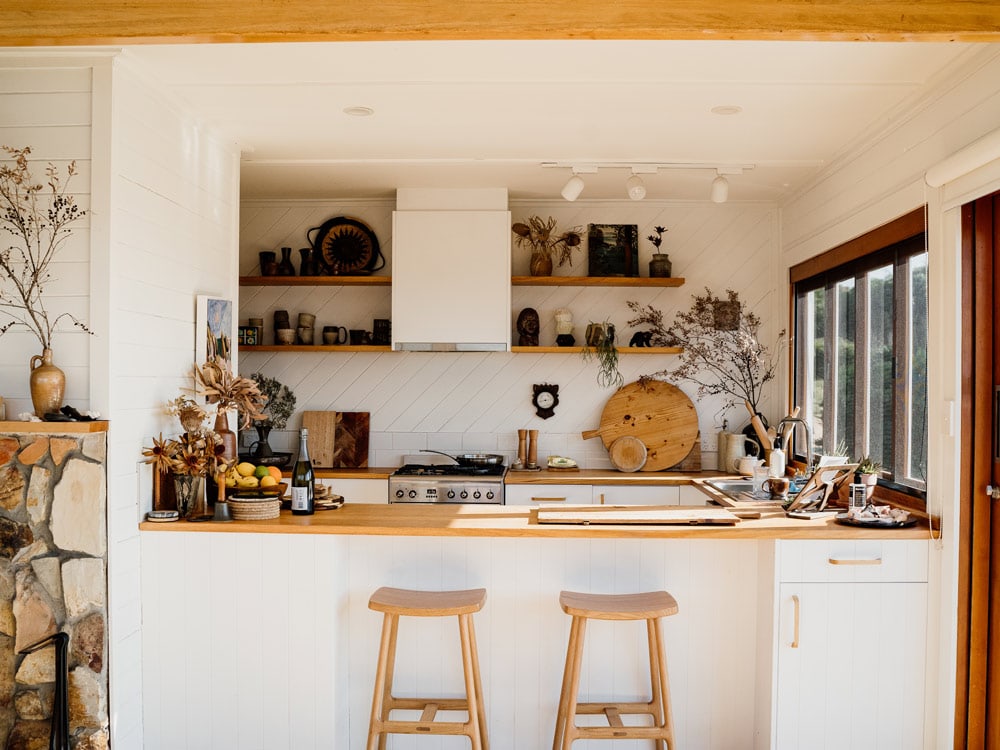
We’ve revealed our pick of 100 unique stays across Australia and below you’ll find the 13 unique stays in Tasmania that made it into our coveted list. Head here to read the full list and start planning your next escape.
On the banks of the river Derwent, set amid elms and flower gardens, sits a grand old house with tales to tell. Convict labour and £1000 saw it built in 1825 for the Constable of Elizabeth Town (now New Norfolk), but these days The Woodbridge Tasmania is pure period luxury. After a night in one of its luscious beds, I pull back the window shutters, letting sunlight and garden views flood in, and I’m reminded of a childhood dream to play lady of the manor. All I’m missing is a silk gown with a very large skirt. Stay at The Woodbridge and you can very easily pretend you own the place. Guests of the eight unique rooms and suites are given free rein and the ‘hired help’ only appear when you need them.

Unwind in the Woodbridge Suite.
It’s a house you don’t want to leave – why would you when you can cosy up by the fire in the drawing room while the pianola plays, retreat to the reading room, or sip a Derwent Valley pinot gris in the garden between dangling your feet in the river? In a real-life Escape to the Chateau story, owners John and Laurelle Grimley lovingly transformed what was a derelict house in 2003 into its current glory, winning HIA Australian Restoration of the Year in 2006. It’s immaculate, oozing with original character and laced with art. The food – served in the Pavilion with its antique birdcage – is something to be savoured. Think pan seared local scallops with cauliflower puree, porcini tortellini, or maple-glazed baked ocean trout. Wines are sourced from the cellar (aka convict lock-up). It’s a taste of genteel country living and it’s a life I could get used to. – Laura Waters
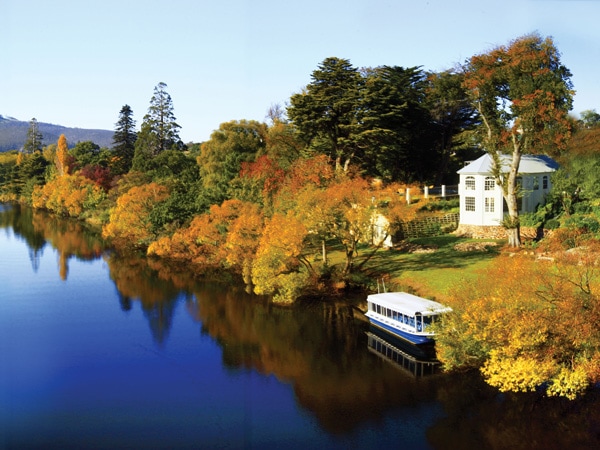
Woodbridge’s picturesque location.
No tarmac roads lead to the little settlement of Corinna. No wi-fi, phone or television leaks news of what’s going on beyond it. It’s bordered by World Heritage Takayna/Tarkine rainforest and rests on the shores of the peaceful Pieman River and, once there, it might as well be the edge of the world. For three days it will be my world.
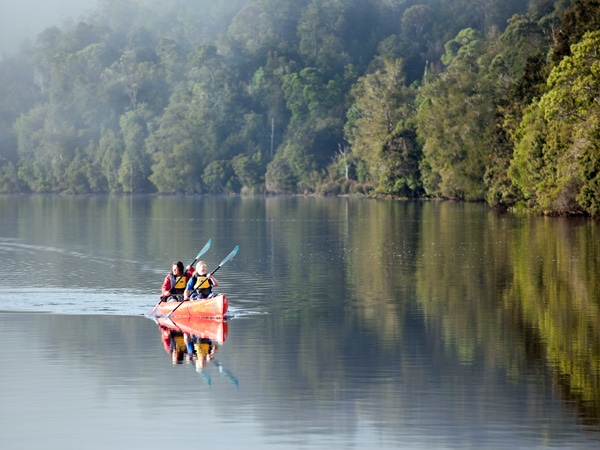
The Corinna Wilderness Experience is bordered by the World Heritage Takayna/Tarkine rainforest.
In the late 1800s, Corinna was bustling with a few thousand gold prospectors, but by 1900 the population began its decline and now the only residents are guests of Corinna Wilderness Experience where a string of timber and corrugated iron cottages have been built in the miner’s cottage style of old. They’re warm, cosy and contain all the mod cons bar a television – I prefer the dancing flames of my fireplace anyway. Central to Corinna is The Tarkine Hotel, a rustic wooden tavern serving hearty meals and Tasmanian beers and wine. In such isolation, connection with the wilderness is immediate and absolute.
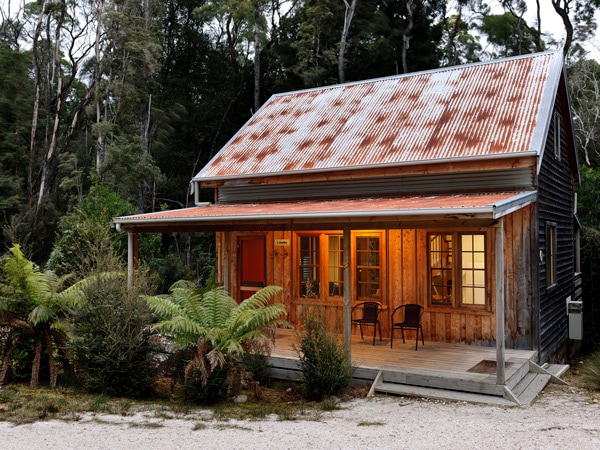
The timber and corrugated iron cottages are warm, cosy and contain all the mod cons bar a television.
The air here is some of the cleanest in the world and though I’ve seen some forests in my time, the Tarkine’s beauty is of mythical proportions. Ten walking trails meander through magnificent trees carpeted in moss and to the tussock-topped Mt Donaldson with its epic views. The Pieman River offers another perspective: a misty morning kayak on its mirror-like waters sees me glide silently past wallabies and diving azure kingfishers, while a cruise on the historic Arcadia II takes me to a remote windswept beach at Pieman Heads. Tassie’s Western Wilds feels like another place and time and, running on solar power and with plans for carbon neutrality, Corinna is doing its best to preserve what is a truly special piece of wilderness. – Laura Waters
There’s a tangible connection the past at Brickendon, especially after 4pm when day visitors leave The World Heritage-listed farm and estate was settled by William Archer in 1824 and now, nearly two centuries later and still with a working farm, descendants Richard and Louise Archer have opened the gates to overnight guests.
I’ve thrown my bags down in the Old Farm Cottage, one of three cottages built in the 1830s by English convicts – men like James Dooley who was sentenced to 14 years for pilfering eight handkerchiefs or the unfortunate John Welch who got life for stealing bacon and cheese (who could blame him?). A free settler, Archer was assigned hundreds of convicts to help build and run the place and, unlike at Port Arthur, convicts here were treated relatively kindly. To wander the village is a step back in time. It’s remarkably raw and free of barriers, as though the original inhabitants might return at any moment.
In William’s first cottage (before the main house was completed) is his suitcase and a single bed with a worn feather doona. There’s a tiny brick chapel, a cookhouse, an array of barns, shearing shed and a blackmith’s shop, untouched since tools were downed in the 1930s. Guests are free to roam and the heritage gardens, set around the Georgian manor, are like a little piece of England with oaks, elms and flowers. As darkness falls on the countryside, there’s even less reminders of the 21st century. My accommodation, once the overseer’s cottage and dairy, combines all the mod cons with old-world style. Door frames encourage ducking. The open wood fire, cleverly set to ignite with a single match, crackles and pops comfortingly as I pour a glass of port from the decanter on the dresser and imagine another time. – Laura Waters
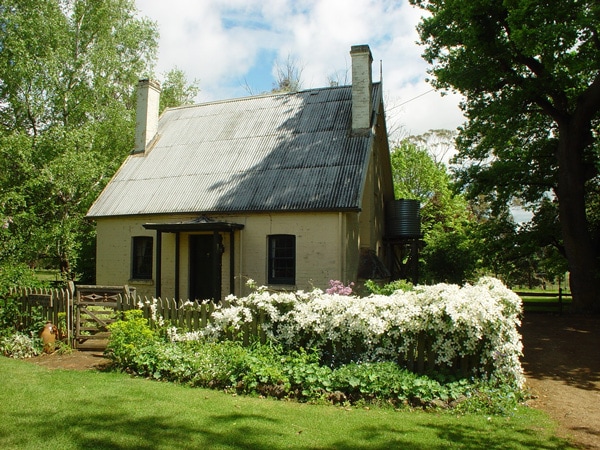
The beautifully historic Old Farm Cottage.
Invariably rugged and beautiful, abundant in wildlife and laden with local produce, Tasmania’s islands enjoy an enviable reputation. One in particular, off the North West coast in the middle of Bass Strait, is increasingly becoming one of the hottest destinations around. King Island is a sliver of land on the doorstep of Melbourne (a 35-minute flight away), yet a whole world removed. And, since opening in late 2019, one luxury eco retreat has helped put it on the map. Run by sea-changers Aaron Suine and Nick Stead, Kittawa Lodge is a destination in itself. Its pair of off-grid, one-bedroom lodges are architecturally designed and sit ocean-facing on a secluded 40-hectare property. With itineraries tailored for you daily according to your interests – and mood that morning – it lets you key straight into the choose-your-own-adventure essence of King Island and will have you feeling like a local in no time.
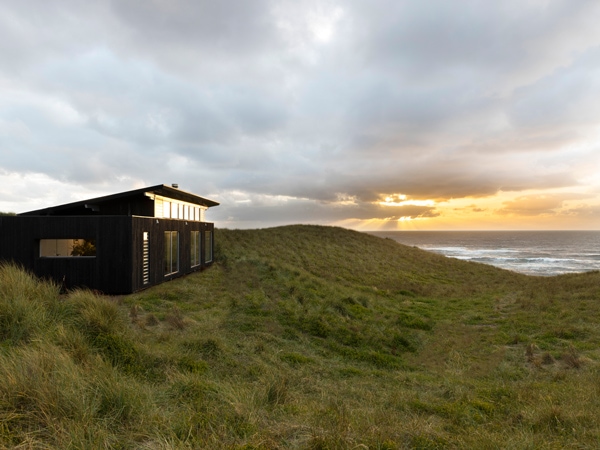
Ocean views are impossible to escape at Kittawa Lodge. (Image: Sammy Green Photography)
As well as a breadth of untouched natural beauty, you’ll find a strong community spirit, thriving art scene and renowned produce – from southern rock lobster, to dry-aged grass-fed beef, sumptuous lamb, local Pacific oysters and the famous King Island Dairy cheese. And, should you wish, you can experience much of this from the luxurious comfort of your lodge; local artworks adorn the walls, and panoramic views of the ever-inquisitive wallabies at the window and white-bellied sea eagles flying above can be enjoyed from a multitude of inviting spots. From the lounge, in front of the crackling fireplace, from your king-size bed or from the handmade concrete bath in your master suite, while sampling a range of premium Tasmanian wines, spirits and beers from your in-lodge bar. Here, Aaron and Nick’s top five ways to experience King Island.
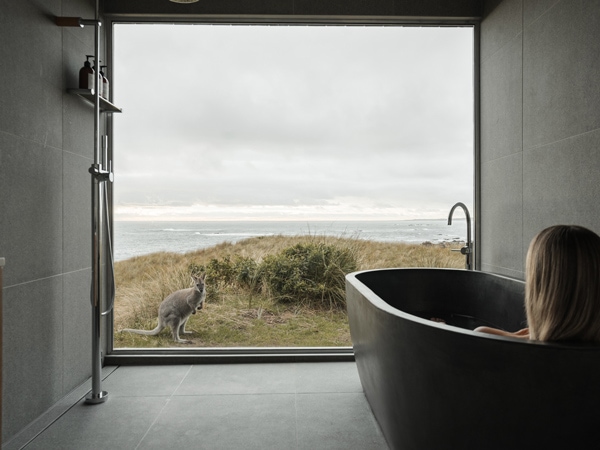
Relax in the bathtub while enjoying the still scenery of King Island. (Image: Oscar Sloane)
1. No trip to King Island is complete without a visit to King Island Dairy, where complimentary cheese tasting plates are available.
2. A southern expedition of the island will thrill the senses, taking in the breathtaking sights of Seal Rocks Reserve, including the Seal Rocks Boardwalk, the Calcified Forest and the Copperhead Walk, as well as the southernmost tip of the island, Stokes Point.
3. An expedition to the north of the island excites for its difference to the south, with the white sandy beaches of Martha Lavinia and Disappointment Bay, as well as the tallest lighthouse in the southern hemisphere, Cape Wickham Lighthouse. We also recommend a trip to Pennys Lagoon, a perched lake on the way to Martha Lavinia.
4. For the golfing enthusiasts, you are spoilt for choice, with some of the world’s best links golf courses: Cape Wickham Golf Links, Ocean Dunes Golf Course and the locally run King Island Golf Course.
5. Just breathe. Kittawa Lodge and King Island Invite guests to sit back and relax, and do as little or as much as you like. Yes, we can fill your days with amazing walks, experiences and sightseeing, but why not take the chance to finish that book, master chess or scrabble, paint a landscape, take a long bath or, as many of our guests do, contemplate and plan for the future?
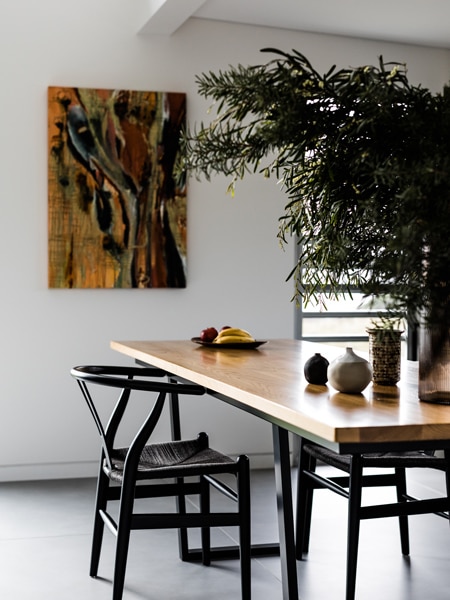
The modern interior details of Kittawa Lodge. (Image: Adam Gibson)
Do you ever think about where the materials of a building you’re staying in might have already been? No, me neither, until I booked myself into shipping container accommodation in Northern Tasmania and fell asleep wondering how many times this bedroom might have crossed Bass Strait. Wynyard is 150 kilometres north-west of Launceston on the Inglis River. The town is Tassie-famous for its annual tulip festival and has a relaxed feel with the promise of an idyllic coastal retirement, like some cold-climate Noosa.
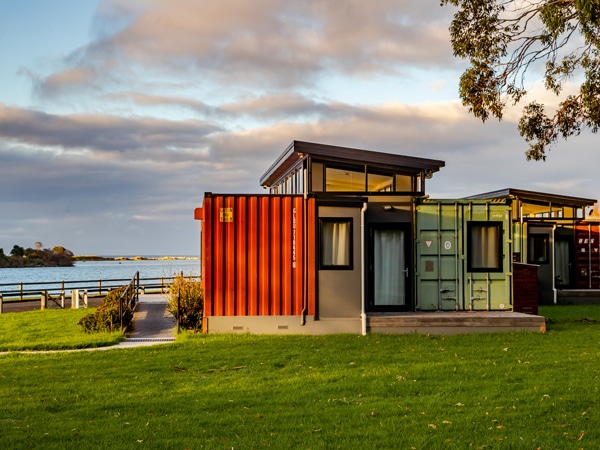
The unique Coastal Pods on the Tasmanian coast. (Image: S. Group)
Cyndia Hilliger and Justin McErlain, who also own the waterfront motel next door, tell me they were inspired by the innovative shipping container architecture they saw in Christchurch as the city recovered from earthquakes. They purchased Containers of Hope plans from Benjamin Garcia Saxe – an award-winning Costa Rican architect dedicated to sustainable sourcing of local materials – and customised to suit. Now two freestanding self-contained accommodation pods, Port and Starboard, sit on the lawn beside the retro motel. Each pod comprises two upcycled shipping containers with decks, polished original plywood floors, spray foam insulation, double-glazing all round and extra soundproofing between bedrooms. The interiors are spacious and the repurposing artful.
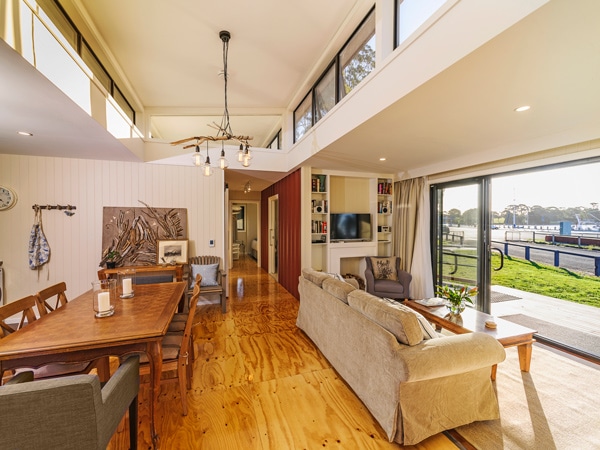
The quirky coastal-inspired interior of the pods. (Image: Kevin O’Daly)
But what really floats my boat is that my Port Pod is rock-solid equal-access accommodation, with great attention given to the details of functionality and no compromise on aesthetics. As good-looking and well-appointed as Starboard, Port has a spa-like bathroom and moveable furniture. Beds can be raised, microwave lowered, equipment hired, whatever’s required. The yacht club, just along Wynyard’s flash new riverside boardwalk, runs a Sailability training program over the warmer months with equipment for people of all abilities. Every evening, vehicle access to the dock closes to the public and, as pod guests, we have this world of moored fishing boats and quiet river all to ourselves. I haven’t caught anything today to cook in the fire pit but luckily the nearby fish and chip shop is open until 7pm and The Wharf Hotel is close by. – Elspeth Callender
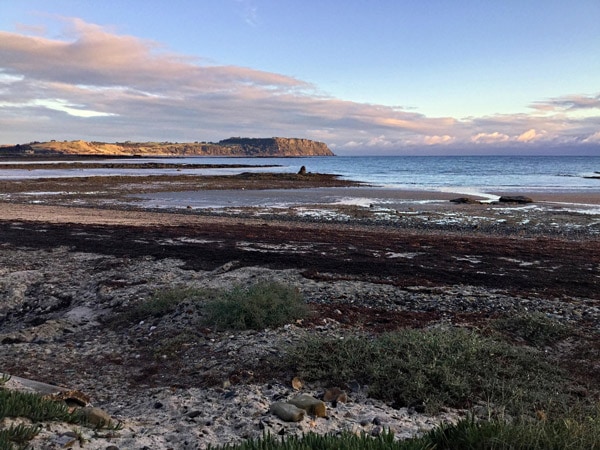
The picturesque location of the Coastal Pods.
It’s the sunrises and sunsets that get me the most. Not mere moments in each day but hour-long spectacles of sherbet skies and piercing golden orbs. Perched on a rocky parcel of Tasmania’s East Coast, the Whale Song shack is a design-lover’s bolthole that brims with curated curiosities, art, books, and the kind of bedding you want to slip into your suitcase.
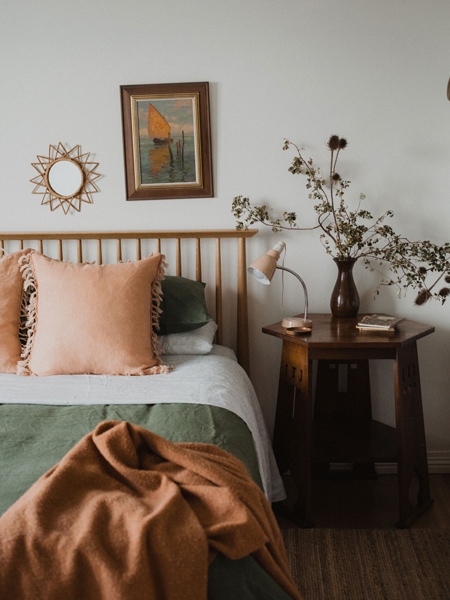
The beautifully designed interior of Whale Song. (Image: Alix Mckenzie)
There are neighbours, but you wouldn’t know it. Until I return, I dream of G&Ts on the deck, candlelit baths in the outdoor tub, setting the needle down on another vinyl, and losing myself in the hypnotic dance of the ocean– an ever-present friend. – Celeste Mitchell
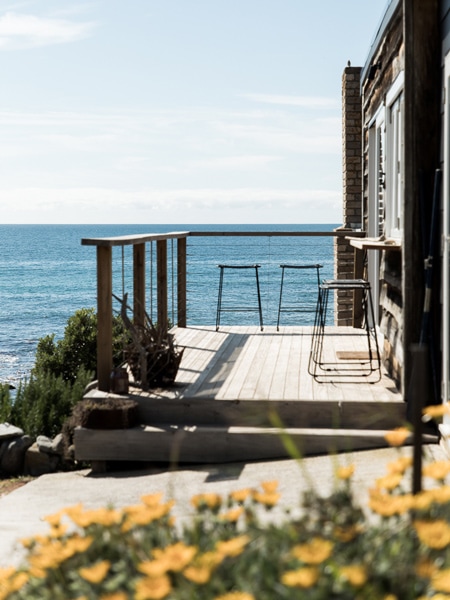
The ocean is at your doorstep at Whale Song. (Image: Natasha Mulhall)
In a cosy loft room of a repurposed Launceston warehouse, I wake from one of the soundest sleeps I’ve had in a long time. Not just because the boutique hotel I am staying in is suitably flash, but because I know my stay has had a positive impact on the outside world. Change Overnight is one of only a few social enterprise hotels in Australia, with every stay supporting one of eight worthy causes.
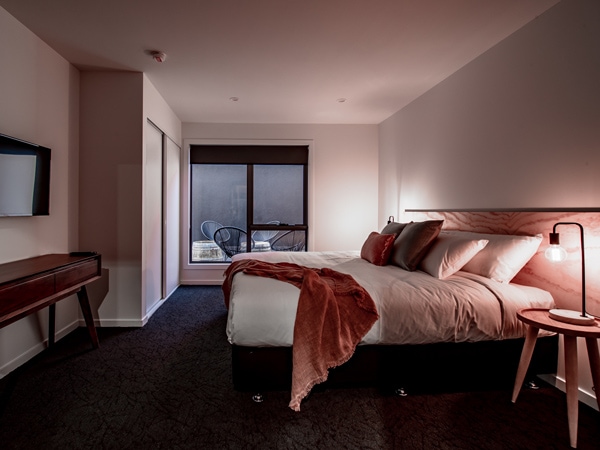
Stay for a good cause at Change Overnight.
Opened in 2019, the property is the brainchild of Tasmanian entrepreneurs Tara Howell and Sam Haberle, who teamed up with likeminded locals Toby Wilkin and Marcel Anstie to form a social capitalist force to be reckoned with. The building’s exterior and entrance are understated. Inside, along a subdued hallway are lettered doors. I’m in F, a one-bedroom, two-storey apartment: when booking, I decided to benefit Be Hers, a not-for-profit organisation dedicated to ending human trafficking. Rooms are decorated with dynamic hand-painted murals and OZ Design furniture, with outdoor seating areas created using the building’s original exterior walls.
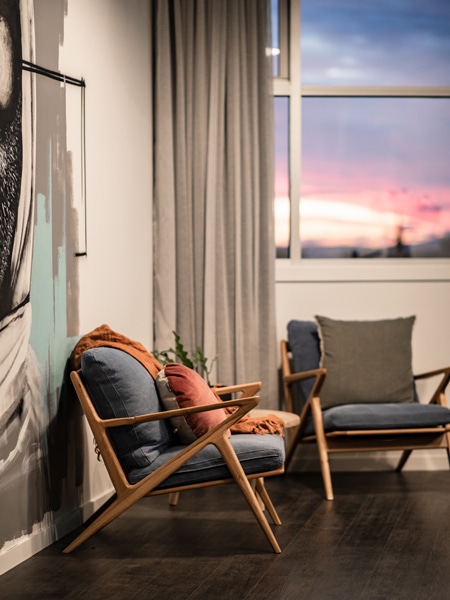
Change Overnight interior details.
There’s also a three-bedroom penthouse where sun streams through a wall of windows into the comfy living room and “Thanks for being a life changer” is stencilled on a door. With self-check-in and keyless access, the property is effectively a hotel version of Airbnb, with apartments kitted out with kitchens, washing machines, free wi-fi and free undercover parking. Change’s eight causes – six chosen by the team and two voted on by the public – range from local to international. The Change team hopes their concept will catch on so that everyone, everywhere, gets a better night’s sleep. – Elspeth Callender
A host ranger greets us when we arrive at each of the three Parks and Wildlife hut sites as independent (non-camping) walkers on the Three Capes Track. All sites have three eight-bed dorms and six rooms with four bunks. And they’re cutting edge in terms of remote comfort and eco design. This 48-kilometre track to the southern hemisphere’s tallest sea cliffs is open year-round. When I walk it in mid-winter, pellet heaters burning processed waste material take the chill off inside. Though, better still, are the sun-catching verandahs for lounging and chatting.
There’s running water, cooking facilities, solar lighting, books, comfy seats and incredible views. Windows are angled to reduce bird strike. And the huts are constructed with fire-retardant material and raised off the ground, so we’d apparently be OK in a bushfire.
– Elspeth Callender
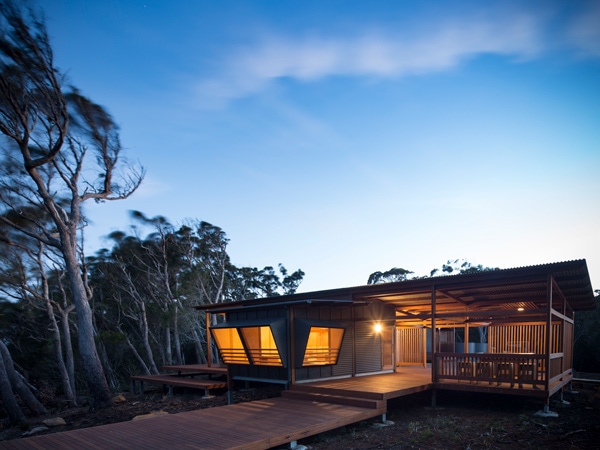
Stay at Three Capes Hut as a base for your hikes. (Image: Brett Boardman Photography Jaws Architects)
The bass strait shimmers silver as we follow the coast road west of Burnie. Silhouetted dramatically against the sky in the fading light of the day, we soon see it. The Nut dominates the landscape for miles around: the remains of an ancient volcanic plug that, standing sentinel above Stanley, shows us where we’re heading. Our home for the next two nights is tucked right at its base. It wasn’t quite on the way from Sydney to Hobart, but then the Ship Inn Stanley is the kind of place you can reasonably detour halfway across the state for. An old sailors’ tavern reimagined as a storytelling inn, in a historic town on the wild and rugged North West coast of Tasmania, it had captured my imagination since it opened in 2019. And it doesn’t disappoint. This artfully luxurious renovation of a drinking establishment dripping in history has been brought to life in such an authentic way that you’d half expect a drunken sailor to stumble through the door in search of revelry. Well, in the Bayview Suite at least.
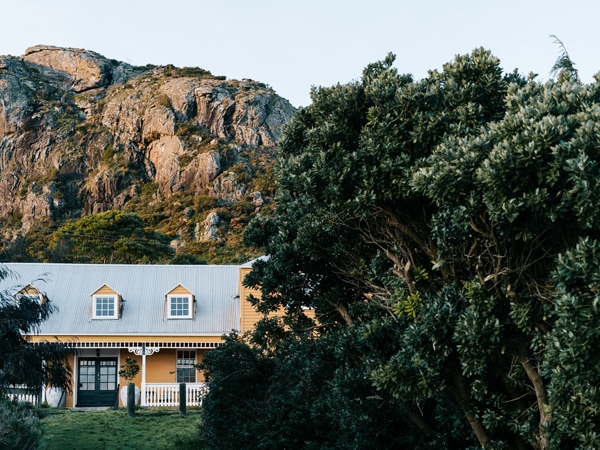
The lovely and modest Ship Inn. (Image: Marnie Hawson).
Tucked in the weatherboard wing of the mustard-yellow two-storey building, our quarters once served as the pub’s old cabaret room. A welcoming plaque speaks of ‘barbarous syncopated rhythms’ that once blared from the gramophone. If only these floorboards could talk. Built in 1849 by a prime minister’s grandfather and the closest pub to the bustling port, the Ship Inn started life as The Shamrock Inn. In the years that followed until it closed its doors in 1972 (falling into disrepair before becoming a private home), it saw a long list of licensees come and go and a melting pot of humanity congregate within its walls. When current owners Kerry and Alastair Houston embarked on their new project to resurrect it as a boutique guesthouse, uprooting from Hobart, they reinstated one of its earliest names. “We soon uncovered so much history about the building and the region that we had to tell the stories,” Kerry told Australian Traveller last year.
The suite my partner and I check into pays homage to the inn’s time trading as the Bayview Hotel. With views across the port, it is elegantly styled and embellished with historical artefacts. The moody tone of green on the walls is the colour of the sky before a thunderstorm and reflects the weather outside as the clouds close in. Cocooned in rich linens with sumptuous feather and down pillows, I’m grateful I’m warm and cosy and not out there on the seas as the rain comes down overnight; up the century-old timber staircase from here, the Wild Wave suite is dedicated to the memory of its namesake tall ship, which met its fate on tumultuous waters in 1923, coming to rest on Tatlows Beach.

Ship Inn bedroom details. (Image: Marnie Hawson)
Across the front verandah from us, the space that was once the bustling bar of the 1800s pub is now a superbly styled two-bedroom apartment that speaks of the seafaring adventures of Roaring Tom, while next door to that is Stanley’s original billiards halls and now The Ghost of Old John Peacock guest lounge, with leather armchairs we’d sunk into earlier that evening over Tassie wine and cheese sourced from the cottage store down the road.
Lyons Retreat tells the tale of Joseph Lyons, Australia’s first Tasmanian-born prime minister who was born in the weatherboard settler’s cottage next door that operates today as a house museum. And Highfield serves a contemporary twist on British culture in a nod to Highfield House and the English gentry who sought to emulate home on an unyielding landscape. This Regency-period homestead perched on a wind-blown promontory overlooking The Nut just out of town was built by convict labour for Edward Curr, chief agent of Van Diemen’s Land Company, and marked the first European occupation in North West Tasmania. Today you can walk the rooms and corridors of this historic site, look out of the yawning French windows with dramatic views over the rugged coastline and learn about the people who lived here. Although the company purported to be committed to the protection of the Tommeginne people, this was not a reality, and the site doesn’t shy away from reflecting on the atrocities that were inflicted on the area’s Traditional Owners, including the 1828 Cape Grim massacre.
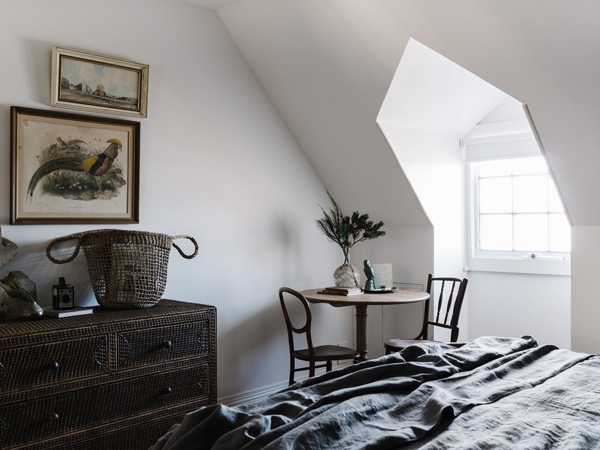
Wake up to the stunning Tasmanian landscape. (Image: Marnie Hawson)
The Ship Inn’s Moo-Nut-Re-Ker suite celebrates the wild beauty of The Nut and is a nod to its palawa name. In the morning the clouds have cleared and the bay below is still. We unwrap our fresh sourdough loaf from the inn’s customised paper and eat it with the provisions left for us: simple but delicious Tasmanian jams, yoghurt, granola and fruit compote. And then there’s nothing else to do than climb The Nut that towers above us. I had expected the goat-track-steep hike to the top (the rather nifty chairlift is closed in the winter) and the world’s-end views out to Bass Strait, but I didn’t expect to find a glorious buttongrass wilderness. Interpretation boards at the first lookout we come to speak of conflict and dispossession of the palawa, the scars on the land around us, but also of the site’s ongoing importance and continuing cultural practices surrounding the moonbirds that proliferate up here. A potoroo ambles across my path and a wallaby rustles in the bush. It’s alive with stories up here as well.
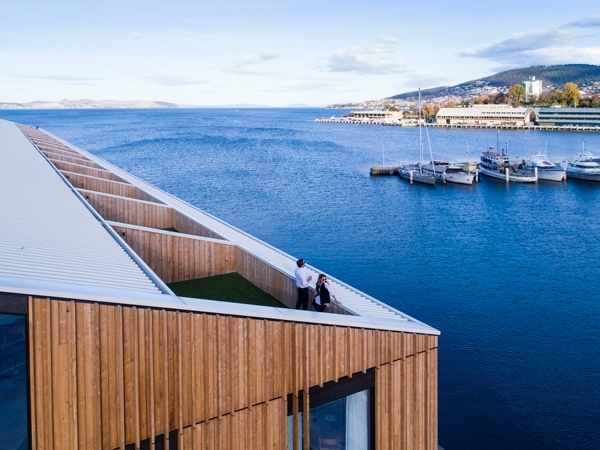
Hobart’s MACq 01 Hotel. (Image: Stu Gibson)
As Australia’s first storytelling hotel, the five-star MACq 01 Hotel was designed to bring Tasmania’s fascinating stories to life. Based on Hobart’s historic Macquarie Wharf, which in previous lives has been a bustling wharf market and later a giant shipping shed, the hotel has 114 rooms matched with 114 unique character tales that give visitors insight into the island state’s storied past: convicts, sailors, beekeepers and Indigenous trailblazers among them. – Imogen Eveson
Before 2021, conversations about the brand Mövenpick in Australia typically might have started with the words “which flavour” and ended with some nom-nom-noms, depending on the palates involved. Outside Australia, the Swiss brand was never simply a purveyor of fine ice-cream and chocolate but also, seemingly incongruently, a luxury hotel chain. Earlier in 2021, Mövenpick Hotel quietly opened in downtown Hobart, in what ostensibly was a Down Under litmus- test (Mövenpick Melbourne on Spencer opened May 2021). Before we discuss the ambience and toiletries of the contemporary 221-room hotel, however, you should become familiar with two significant words associated with Mövenpick hotels worldwide: ‘Chocolate Hour’. Perish thoughts of chubby kids gulping ganache from water features and gnawing through furnishings Augustus-Gloop style. The premium brand’s daily ritual is executed in a more refined, subtle, some would say ‘Swiss’, way.
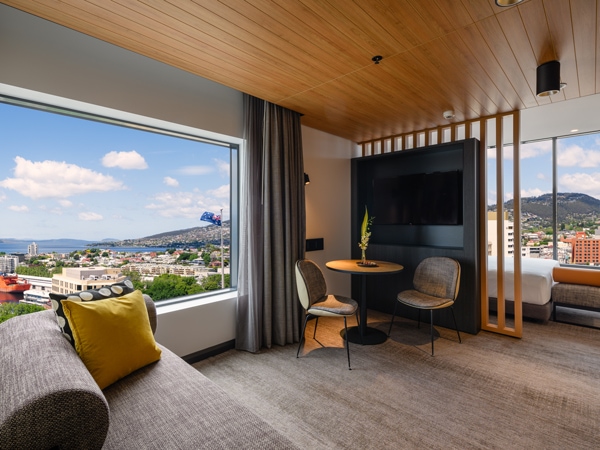
Mövenpick Hotel quietly opened in downtown Hobart, in early 2021. (Image: Loic Le Guilly)
Peak adoption of chocolate hour involves culinary climbing of a three-tier chocolate-tower – ‘chock’ full of éclairs, brownies and truffles – coupled with [insert preferred number here] chocolate-inspired cocktails. Executive chef Trent Whelan delegates the sweet complexities to his full-time chocolatier. “We try to use everything local, right down to Tasman sea salt for our salted caramel,” says Whelan. “We infuse chocolate with locally grown saffron [from Tas-Saff], locally grown lavender and local alcohols.” Punishingly, Trent samples the “crazy” new fillings every day (the tea-infusions are his favourites), sometimes “sneaking up there” after the chocolatier goes home.
Given its decadent-ice-cream heritage, you might expect Mövenpick’s cocktails to be elaborate schnapps-fortified choccy milkshakes. Ahhh, no. The emphasis is on chocolate-inspired drinks paired with the sweets du jour. For example, cognac-infused Tasmanian cherries are the stars of ‘Pick Your Move’, with chocolate bitters just one of the thoughtful extras. With all-day tasting packages and a locally built chocolate cart soon to grace the lobby, you can make it ‘Chocolate Day’ if you wish. And although the hotel is “not an ice-cream bar”, petite tubs of ‘Vanilla Dream’ and the like lie in wait.
For those high-maintenance individuals who cannot live by chocolate alone, Mövenpick’s 85-seat Italian restaurant, Tesoro (‘treasure’ in Italian) has fast become one of downtown Hobart’s go-to eateries. Essentially the hotel’s common area, it synthesises buzzy with laid-back, offering a refined cocoon from the busy mall outside. “It’s not a special-occasion restaurant,” say Whelan. “I wanted it to be somewhere you can be on a midweek Tinder date and come back to with your parents on the weekend.”
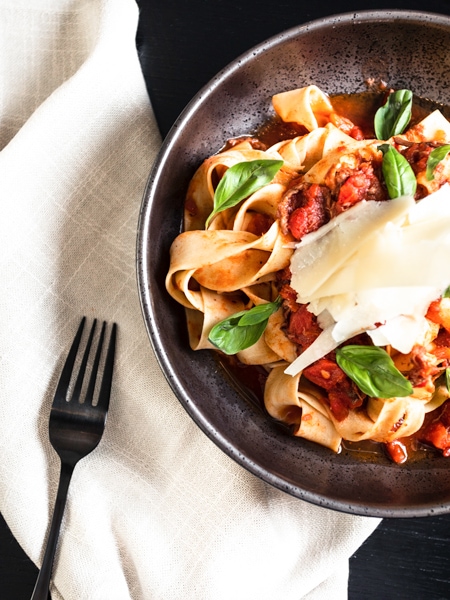
Mövenpick’s 85-seat Italian restaurant, Tesoro has become one of downtown Hobart’s go-to eateries.
The fundamentals of the gel- and foam-free “modern rustic” Italian are handmade in-house, including various pastas, slow-ferment sourdough for pizza bases and house- limoncello. Whelan also ages Cape Grim Beef for 50 days in the ‘treasure chest’ and he’s on a one-man focaccia-revival mission. Above the food-line, the Jaws Architects-designed rooms match Tesoro’s culinary ethos – contemporary, refined and generous.
Although I couldn’t quite find the claimed ‘tonal qualities of the Tasmanian landscape’ in my 18th-floor suite, the slick, light spaces are prolifically stocked with all you should need, from Biology lotions to Tasmanian whiskies. The upper rooms in particular are rich in panorama (harbour and Kunanyi/Mt Wellington views). The only question is whether Chocolate Hour can tempt you away from Hobart’s sweet boutique options, like Henry Jones Art Hotel and MACq 01. I guess that’s just a matter of taste(buds). – Steve Madgwick
Designer rugs are thick; the bathroom has an in-wall waterproof television; clean-lined living spaces are decorated with bespoke Tasmanian furniture. Is that a pre-Columbian grinding stone encased in glass – in the kitchen?
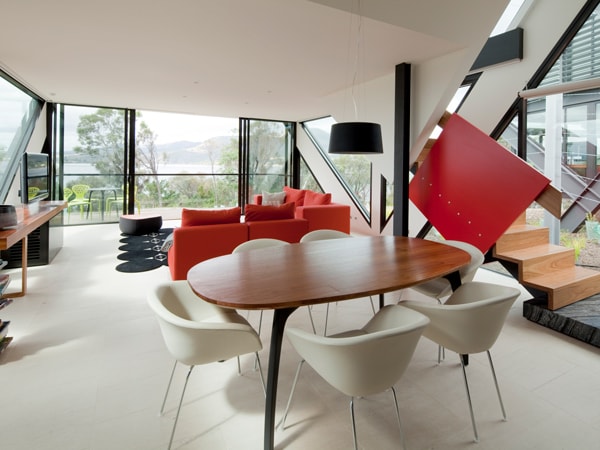
The lounge inside the Walter Pavilion. (Image: Brett Boardman)
Each named after an influential Australian painter or architect, Mona Pavilions’ eight dens have walls adorned with the artwork of their namesake. From the lounge suite of my ‘Brett’ I admire a Whiteley. Is that an original? Of course. The pick of the penthouses is ‘Roy’, in all its three-storey, silver metallic skin glory. With two bedrooms separated by a middle-level living space, two couples (or a family) could go halves and nab themselves the biggest pavilion at a reasonable price. The only drawback? They might fight over who gets the bedroom with the spa bath on the deck.
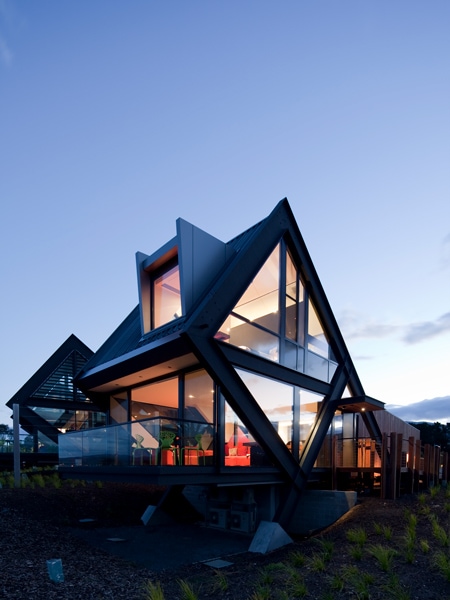
Each of Mona Pavilions’ eight dens is named after an influential Australian painter or architect. (Image: Brett Boardman)
Next to ‘Roy’ is a sybaritic fitness centre where I enjoyed many hours gazing at the glass-like River Derwent while floating in the infinity pool. A sauna and gymnasium add to the quiet opulence of the exercise zone. The pavilions’ location next to the Museum of Old and New Art, with its on-site winery and cellar door, just 15 minutes from Hobart CBD, only enhances its standing as the epitome of Tasmanian luxury. With breakfast at The Source Restaurant (I had impeccable eggs on wood-fired bread) included in the rate, I didn’t need to road-test many of the European kitchen appliances in my self-contained ‘Brett’. But who could miss a thorough investigation of the fully stocked wine fridge? Life is stylish when I’m staying at Mona. – Leah McLennan
It’s hard to divert attention from the rugged beauty of Tasmania’s Freycinet Peninsula, given just how jaw-on-the-floor dramatic the area is, but a collection of blissfully situated pavilions are managing to rival the impossibly blue waters of Wineglass Bay and the soaring heights of The Hazards. Part of the eco-focused Freycinet Lodge, situated within Freycinet National Park, the Coastal Pavilions, dotted within bushland at the water’s edge, are strikingly stylish.
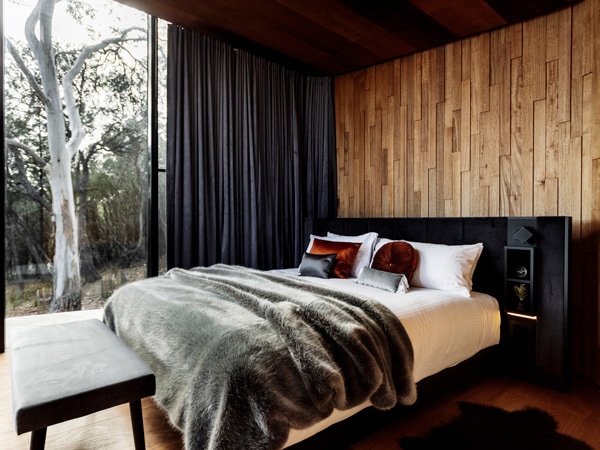
The interior design of the Coastal Pavilions delivers an irresistibly cocooning effect. (Image: RACT Destinations)
Outside it’s all curved picture windows and charred Red Ironbark, with generous decks (complete with outside bathtubs) to relax on, while inside the effect is irresistibly cocooning, with patch-worked Tasmanian oak, blackwood and plywood throughout (finding the hidden toilet and games-stacked cupboard is hide-and-seek fun), a stunning bathroom, huge king bed and cosy lounge area complete with a modern fireplace. Bet all that got your attention, didn’t it? – Leigh-Ann Pow
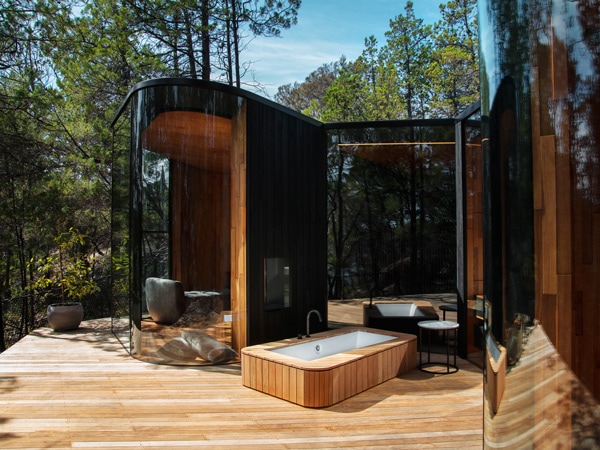
Relax in the outdoor bathtub situated on the generous sized deck. (Image: RACT Destinations)
Gauze separates my sleeping self from the coastal heathland. The domed ceiling and wallaby throw across my body are inspired by the traditional homes and lifestyles of the palawa – First Nations peoples of lutruwita (Tasmania). Fittingly, krakani lumi means resting place. Storytelling is interwoven in the award-winning design of these freestanding sleeping shelters.
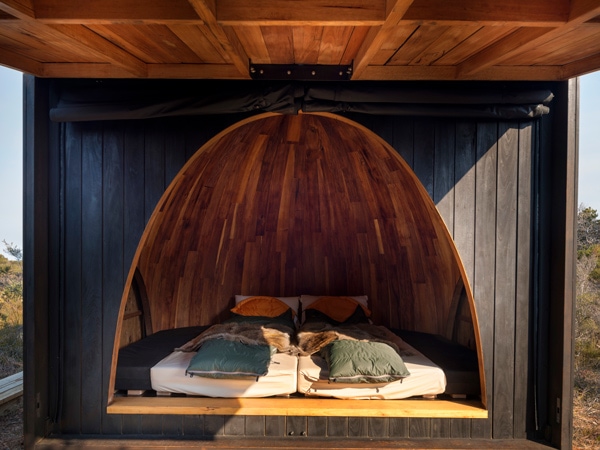
The freestanding sleeping shelters are home for two wukalina Walk nights. (Image: Rob Burnett)
Warm tones and curved lines extend to the communal building where, after all hiking here together, guides grilled up muttonbird on the fire pit and performed a Smoking Ceremony. This low impact off-grid standing camp in the state’s North East areas of wukalina (Mt William National Park) and larapuna (Bay of Fires) is home for two wukalina Walk nights. There is no other place or overnight experience like this in the world. – Elspeth Callender
LEAVE YOUR COMMENT